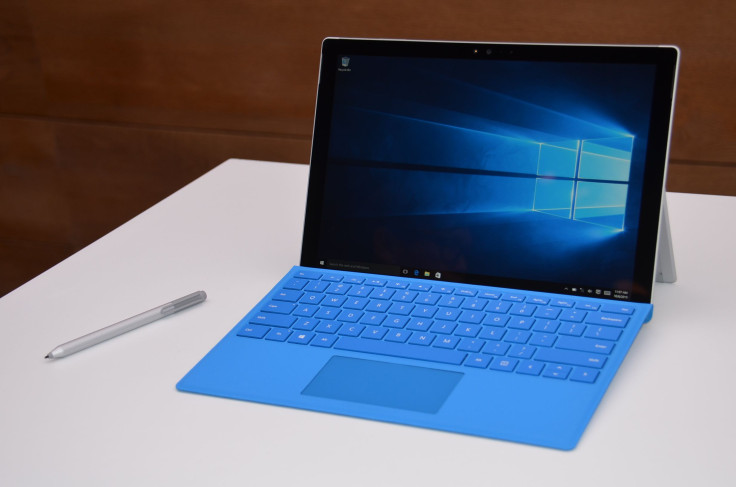Microsoft Surface Pro 4 Is The Tablet-As-Computer Apple's iPad Pro Should Have Been

Microsoft just made a bold pitch for the high end of the tablet market, a rarefied space where a tablet can replace a laptop, or conversely, your laptop could just be a tablet. The Surface Pro 4 pits the company against Apple's iPad Pro and Google's Pixel C, all three of which promise to be something between a laptop and a tablet. Microsoft CEO Satya Nadella unveiled the latest Surface Tuesday at a media event in Manhattan.
The Surface Pro 4 packages all this in a sleek new design that improves on the previous three iterations. Is Microsoft onto a winner? Or have they lost the 2-in-1 market to the new kids on the block?
Apps
The Surface Pro 4 is the only one of the three to run an operating system that can support full desktop apps. Make no mistake: If it's a Windows program, it'll run on the Surface. Apple and Google can argue all they like that iOS and Android can support "desktop-class" apps, but chances are, if you're the sort of person that uses a lot of different apps on your desktop, you'll be best supported by Surface.
Speed
The Surface Pro 4 comes with an Intel Skylake processor, while the iPad Pro has a custom-designed Apple A9X chip and the Pixel C has an Nvidia Tegra X1 chip. The problem, as it is in a lot of modern technology comparisons, is that chips only tell a fraction of the story. Apple's OS, for example, has been custom-written for the hardware it's going to be running on, and the A9X is the fastest chip Apple has ever made. However, the Intel Skylake family, new for this year, has a renewed focus on speed in mobile devices, and Microsoft claims it is 50 percent faster than a MacBook Air. However, until we get some Geekbench scores, the jury's out.
Memory
The iPad Pro also has 4GB of memory, more RAM than any other iOS device. That's also more than the Pixel C's 3GB, but it's no match for the Surface Pro 4's 16GB maximum. In terms of day-to-day memory, the Surface Pro may seem the better choice, but the way these two operating systems handle their RAM capacity will differ considerably. Apple's iOS, for example, strives to ensure that the user doesn't need to manage running apps, but can only run two apps side by side. The Surface Pro will be able to put that RAM through its paces with a multiwindowed interface, but like a traditional PC you will need to keep abreast of what's currently open.
Stylus
The iPad Pro and the Surface Pro 4 support styluses; both devices need charging and both offer multiple levels of pressure for advanced sketching and writing. However, the Pro 4 comes with an eraser on the other end of its stylus, making it a better choice for artists who don't want to keep switching virtual tools on a screen to correct their work. The Pro 4 has 1024 levels of pressure sensitivity and a magnetic clip to store the pen on the side of the device. The iPad Pro, on the other hand, offers unspecified levels of pressure sensitivity and tilt detection for broader strokes. The Pixel C doesn't support a stylus. It's a tough call between iPad Pro and Pro 4, but there's one spec that swings it: While the iPad Pro stylus lasts 12 hours on a single charge, the Pro 4 will last up to an entire year on a single replaceable battery. The Pro 4 it is.
Keyboard
The Pixel C does not support a keyboard connector, instead opting for a Bluetooth keyboard that inductively charges when connected to the tablet. This may not be as much of an issue as it seems, particularly if the keyboard is automatically charging anyway. The iPad Pro has a smart keyboard that doesn't require batteries, but the Surface Pro 4 blows that away with a newly-engineered silent keyboard with deep key travel. Oh, and it has a glass trackpad if you don't feel like waving your arms around. Another check for the Pro 4.
Price
The Surface Pro 4 starts at $899, the iPad Pro starts at $799 and the Pixel C starts at $499. The Pixel C is competing more with the lower end of the tablet spectrum, and while it has some similarities with the iPad Pro and Surface Pro 4, it makes a lot of compromises. If you're looking for the potential to replace your laptop, the above restrictions don't bother you, and you're on a tight budget, the Pixel C will let you work on an Android-based 2-in-1 tablet for a fraction of the cost.
Conclusion
The Surface Pro 4 is the best of the three if you want your tablet to replace your laptop. But are we at that stage yet? The Surface Pro 4 is still larger than most tablets out there, and the Pixel C comes closer to that classic form factor that lends itself so well to relaxing on a sofa. The iPad Pro, meanwhile, seems to take Apple's existing success in the tablet space and try to push it into a Surface-like form. Apple's tablet doesn't really run different software than the iPad Air 2 though, meaning its only real strengths are a keyboard, stylus and bigger screen. All of which you can get on a Surface Pro 4. For those who want the best of both worlds, without suffering through the software restrictions of a tablet, the Surface Pro 4 is the clear winner.
© Copyright IBTimes 2024. All rights reserved.






















